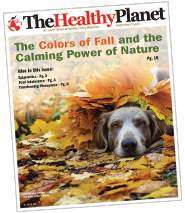With Michelle “Mike” Ochonicky
Healthy Planet Arts Editor
Arts Integration + Arts Collaboration = Good for All
Arts integration is the new buzz. It’s a sad fact that when budgets are tight in school districts, the arts are first to be reduced or even eliminated. That’s a serious mistake because we know the schools that value and support arts programs also have higher test scores across all subjects. The arts are critical for students’ full growth potential. Savvy educators are at work developing ways to include arts into core curriculum subjects, providing even students in districts with limited curriculum some exposure to the arts. That experience fosters lifelong appreciation for the arts, an enhanced quality of life. Illustrating a written assignment, considering the mathematical balance of a piece of music, acting out a literary reading—any way to incorporate the arts into other subjects is good.
Kudos to the Pulitzer Arts Foundation for presenting the Marfa Dialogues this summer as a continuing examination of artistic practice, climate change science, and civic engagement. The arts bring more than beauty to the world; they bring creative thinking that can result in creative solutions to many of the world’s concerns. The program wraps up on August 3. Later this month, the Pulitzer’s building will be closed for renovation until its new exhibition opens in 2015. To find out the results of these important meetings, visit www.marfadialogues.org.
Taken a step further, some cities request (or even require) that art be included in new construction. In 1997 the city of Columbia, Missouri initiated the Percent for Art Program to provide greater access to the arts for diverse audiences in varied settings. The concept sparked by the city’s Office of Cultural Affairs developed into an established program that requires 1% of a public building’s cost to be allotted for the inclusion of a work of art. Columbia is one of just two communities in Missouri to have an established Percent for Art program, the other being Kansas City, Missouri.
The basis for the Percent for Art Program is not “art for art’s sake,” but rather its intention is to create civic pride, promote economic development and enhance the public welfare while improving and expanding the value and use of public buildings and facilities.
By the end of 2011, twelve large-scale site-specific public art projects had been completed or initiated in Columbia since the program was launched. Although some works are free-standing, some are incorporated right into new building. For example, a new fire station features a stained block-glass work instead of a plain glass window. To date, more than $750,000 has been allocated to these projects, mostly in the form of payments to individual artists. Often commissioned artists hire local contractors and suppliers to complete and install the work, further cementing the connection between art and commerce. Site-specific public art reinforces the idea that art should be an everyday aspect for everyone to enjoy.
While St. Louis has yet to develop a program such as mentioned above, public art is gaining attention as it is integrated into everyday places. And that’s a good thing! StL250’s fun “birthday” cake sculptures provide surprises throughout the metro area during this the city’s celebration year. Wouldn’t it be great to have similar public installations on a regular (maybe biennial) basis?
Along with integration, the concept of collaboration is major, especially in the arts. Arts organizations are finding that they can accomplish much more by working in partnership with other groups in our community than any one group could ever do alone. It just makes sense to pool resources. Art-funders want to see that the money they give to nonprofit arts groups is stretched as much as possible — and collaboration is the way to do that.
Sometimes the art is “the” major attraction. No one goes to Millennium Park in Chicago without snapping pictures of Anish Kapoor’s “Cloud Gate” sculpture (affectionately referred to as “The Bean”). The giant silver sculpture allows visitors intriguing reflections of the city surrounding it. It’s constantly surrounded by crowds. The same excitement is being generated right now in downtown St. Louis.
How could anyone miss the Arch when crossing the Mississippi into St. Louis? It’s more than a sculpture; it’s a magnet! And its pull promises to be even more powerful as the CityArchRiver 2015 Project moves along. The public-private collaboration of this invigorating project is inspiring.
Part of the CityArchRiver 2015 Project includes a temporary public art exhibition on the Mississippi Riverfront. This project kicks off in August to give visitors more to explore. Earlier this year, Great Rivers Greenway and CityArchRiver sent out a Call for Curators. As we go to press, three internationally known finalists are under consideration, with the selected curator to be announced in mid-August.
Visit www.cityarchriver.org to learn more.


